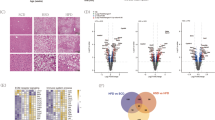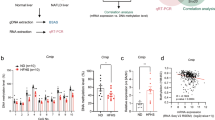Abstract
Nonalcoholic fatty liver disease (NAFLD) is now the most common cause of chronic liver disease among children and adolescents in the developed world. Betaine, as a methyl donor, recently has been demonstrated to exert its hepatoprotective effects through rectifying the genomic DNA hypomethylation state. However, whether betaine supplementation affects N6-methyladenosine (m6A) mRNA methylation in NAFLD is still unknown. We conducted the current study to investigate the effects of betaine supplementation during adolescence on high-fat diet-induced pathological changes in liver of mice, and we further identified the effects of betaine supplementation on expression of the fat mass and obesity-associated gene (FTO) and hepatic m6A mRNA methylation. Our results showed that betaine supplementation across adolescence significantly alleviated high-fat-induced impairment of liver function and morphology as well as ectopic fat accumulation. Surprisingly, no significant effects on serum TG and NEFA level, as well as fat mass, were observed in mice supplemented with betaine. We also found that high-fat diet upregulated ACC1 and FAS gene expression and downregulated HSL and ATGL gene expression. However, these alterations were rectified by betaine supplementation. Moreover, an m6A hypomethylation state and increased FTO expression were detected in mice fed with high-fat diet, while betaine supplementation prevented these changes. Our results suggested that betaine supplementation during adolescence could protect mice from high-fat-induced NAFLD by decreasing de novo lipogenesis and increasing lipolysis. Furthermore, a novel FTO-dependent function of m6A may involve in the hepatoprotective effects of betaine.





Similar content being viewed by others
References
Alisi A, Feldstein AE, Villani A, Raponi M, Nobili V (2012) Pediatric nonalcoholic fatty liver disease: a multidisciplinary approach. Nat Rev Gastroenterol Hepatol 9(3):152–161
Anderson EL, Howe LD, Fraser A, Callaway MP, Sattar N, Day C, Tilling K, Lawlor DA (2014) Weight trajectories through infancy and childhood and risk of non-alcoholic fatty liver disease in adolescence: the ALSPAC study. J Hepatol 61(3):626–632
Browning JD, Horton JD (2004) Molecular mediators of hepatic steatosis and liver injury. J Clin Invest 114(2):147–152
Cai D, Jia Y, Lu J, Yuan M, Sui S, Song H, Zhao R (2014) Maternal dietary betaine supplementation modifies hepatic expression of cholesterol metabolic genes via epigenetic mechanisms in newborn piglets. Br J Nutr 112(9):1459–1468
Cheung CR, Kelly DA (2011) Non-alcoholic fatty liver disease in children. BMJ 343:d4460
Cholewa JM, Guimaraes-Ferreira L, Zanchi NE (2014) Effects of betaine on performance and body composition: a review of recent findings and potential mechanisms. Amino Acids 46(8):1785–1793
Cordero P, Gomez-Uriz AM, Campion J, Milagro FI, Martinez JA (2013) Dietary supplementation with methyl donors reduces fatty liver and modifies the fatty acid synthase DNA methylation profile in rats fed an obesogenic diet. Genes Nutr 8(1):105–113
Cordero P, Milagro FI, Campion J, Martinez JA (2014) Supplementation with methyl donors during lactation to high-fat-sucrose-fed dams protects offspring against liver fat accumulation when consuming an obesogenic diet. J Dev Orig Health Dis 1:1–11
Dou X, Xia Y, Chen J, Qian Y, Li S, Zhang X, Song Z (2014) Rectification of impaired adipose tissue methylation status and lipolytic response contributes to hepatoprotective effect of betaine in a mouse model of alcoholic liver disease. Br J Pharmacol 171(17):4073–4086
Hess ME, Bruning JC (2014) The fat mass and obesity-associated (FTO) gene: obesity and beyond? Biochim Biophys Acta 1842(10):2039–2047
Jang A, Kim D, Sung KS, Jung S, Kim HJ, Jo C (2014) The effect of dietary alpha-lipoic acid, betaine, l-carnitine, and swimming on the obesity of mice induced by a high-fat diet. Food Funct 5(8):1966–1974
Ji C, Kaplowitz N (2003) Betaine decreases hyperhomocysteinemia, endoplasmic reticulum stress, and liver injury in alcohol-fed mice. Gastroenterology 124(5):1488–1499
Jia G, Fu Y, Zhao X, Dai Q, Zheng G, Yang Y, Yi C, Lindahl T, Pan T, Yang YG, He C (2011) N6-methyladenosine in nuclear RNA is a major substrate of the obesity-associated FTO. Nat Chem Biol 7(12):885–887
Kharbanda KK, Rogers DD 2nd, Mailliard ME, Siford GL, Barak AJ, Beckenhauer HC, Sorrell MF, Tuma DJ (2005) Role of elevated S-adenosylhomocysteine in rat hepatocyte apoptosis: protection by betaine. Biochem Pharmacol 70(12):1883–1890
Lawlor DA, Callaway M, Macdonald-Wallis C, Anderson E, Fraser A, Howe LD, Day C, Sattar N (2014) Nonalcoholic fatty liver disease, liver fibrosis, and cardiometabolic risk factors in adolescence: a cross-sectional study of 1874 general population adolescents. J Clin Endocrinol Metab 99(3):E410–E417
Lever M, Slow S (2010) The clinical significance of betaine, an osmolyte with a key role in methyl group metabolism. Clin Biochem 43(9):732–744
Memon RA, Grunfeld C, Moser AH, Feingold KR (1994) Fatty acid synthesis in obese insulin resistant diabetic mice. Horm Metab Res 26(2):85–87
Meyer KD, Jaffrey SR (2014) The dynamic epitranscriptome: N6-methyladenosine and gene expression control. Nat Rev Mol Cell Biol 15(5):313–326
Narayan P, Rottman FM (1992) Methylation of mRNA. Adv Enzymol Relat Areas Mol Biol 65:255–285
Niu Y, Zhao X, Wu YS, Li MM, Wang XJ, Yang YG (2013) N6-methyl-adenosine (m6A) in RNA: an old modification with a novel epigenetic function. Genomics Proteomics Bioinformatics 11(1):8–17
Oddy WH, Herbison CE, Jacoby P, Ambrosini GL, O’Sullivan TA, Ayonrinde OT, Olynyk JK, Black LJ, Beilin LJ, Mori TA, Hands BP, Adams LA (2013) The Western dietary pattern is prospectively associated with nonalcoholic fatty liver disease in adolescence. Am J Gastroenterol 108(5):778–785
Pekkinen J, Olli K, Huotari A, Tiihonen K, Keski-Rahkonen P, Lehtonen M, Auriola S, Kolehmainen M, Mykkanen H, Poutanen K, Hanhineva K (2013) Betaine supplementation causes increase in carnitine metabolites in the muscle and liver of mice fed a high-fat diet as studied by nontargeted LC-MS metabolomics approach. Mol Nutr Food Res 57(11):1959–1968
Schwimmer JB, Deutsch R, Kahen T, Lavine JE, Stanley C, Behling C (2006) Prevalence of fatty liver in children and adolescents. Pediatrics 118(4):1388–1393
Song Z, Deaciuc I, Zhou Z, Song M, Chen T, Hill D, McClain CJ (2007) Involvement of AMP-activated protein kinase in beneficial effects of betaine on high-sucrose diet-induced hepatic steatosis. Am J Physiol Gastrointest Liver Physiol 293(4):G894–G902
Sparks JD, Collins HL, Chirieac DV, Cianci J, Jokinen J, Sowden MP, Galloway CA, Sparks CE (2006) Hepatic very-low-density lipoprotein and apolipoprotein B production are increased following in vivo induction of betaine-homocysteine S-methyltransferase. Biochem J 395(2):363–371
Swiderska-Syn M, Suzuki A, Guy CD, Schwimmer JB, Abdelmalek MF, Lavine JE, Diehl AM (2013) Hedgehog pathway and pediatric nonalcoholic fatty liver disease. Hepatology 57(5):1814–1825
Vajro P, Lenta S, Socha P, Dhawan A, McKiernan P, Baumann U, Durmaz O, Lacaille F, McLin V, Nobili V (2012) Diagnosis of nonalcoholic fatty liver disease in children and adolescents: position paper of the ESPGHAN Hepatology Committee. J Pediatr Gastroenterol Nutr 54(5):700–713
Wang W, Kramer PM, Yang S, Pereira MA, Tao L (2001) Reversed-phase high-performance liquid chromatography procedure for the simultaneous determination of S-adenosyl-L-methionine and S-adenosyl-L-homocysteine in mouse liver and the effect of methionine on their concentrations. J Chromatogr B Biomed Sci Appl 762(1):59–65
Wang Z, Yao T, Pini M, Zhou Z, Fantuzzi G, Song Z (2010) Betaine improved adipose tissue function in mice fed a high-fat diet: a mechanism for hepatoprotective effect of betaine in nonalcoholic fatty liver disease. Am J Physiol Gastrointest Liver Physiol 298(5):G634–G642
Wang LJ, Zhang HW, Zhou JY, Liu Y, Yang Y, Chen XL, Zhu CH, Zheng RD, Ling WH, Zhu HL (2014) Betaine attenuates hepatic steatosis by reducing methylation of the MTTP promoter and elevating genomic methylation in mice fed a high-fat diet. J Nutr Biochem 25(3):329–336
Zeisel SH (2006) Betaine supplementation and blood lipids: fact or artifact? Nutr Rev 64(2 Pt 1):77–79
Zhao X, Yang Y, Sun BF, Shi Y, Yang X, Xiao W, Hao YJ, Ping XL, Chen YS, Wang WJ, Jin KX, Wang X, Huang CM, Fu Y, Ge XM, Song SH, Jeong HS, Yanagisawa H, Niu Y, Jia GF, Wu W, Tong WM, Okamoto A, He C, Rendtlew Danielsen JM, Wang XJ, Yang YG (2014) FTO-dependent demethylation of N6-methyladenosine regulates mRNA splicing and is required for adipogenesis. Cell Res 24(12):1403–1419
Acknowledgments
This work was supported by the Special Fund for Cultivation and Breeding of New Transgenic Organism (Grant No. 2014ZX0800949B) and National Basic Research Program of China (Grant No. 2012CB124705).
Author information
Authors and Affiliations
Corresponding author
Additional information
Jingqing Chen and Xihong Zhou contributed equally to this work.
Rights and permissions
About this article
Cite this article
Chen, J., Zhou, X., Wu, W. et al. FTO-dependent function of N6-methyladenosine is involved in the hepatoprotective effects of betaine on adolescent mice. J Physiol Biochem 71, 405–413 (2015). https://doi.org/10.1007/s13105-015-0420-1
Received:
Accepted:
Published:
Issue Date:
DOI: https://doi.org/10.1007/s13105-015-0420-1




